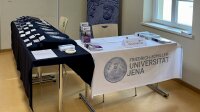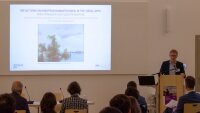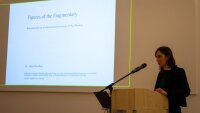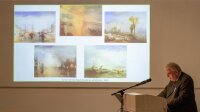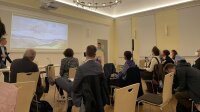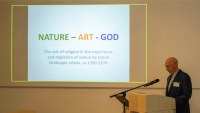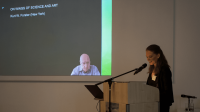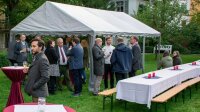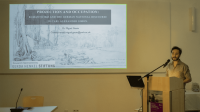
- Liberty
- Professur für Neuere Kunstgeschichte
Meldung vom:
Zur Original-Meldung
Reflections on European Romanticism(s) in the Visual Arts: State of Research and Future Perspectives
(Friedrich Schiller University Jena, 14–16 September 2022)
Almost 100 years ago, in 1924, Arthur O. Lovejoy raised the fundamental question of whether Romanticism could be characterised as a comprehensive movement that transcended national and linguistic borders. Lovejoy’s critical reflections on the diversity of Romanticisms have met with divided responses. While some researchers, notably René Wellek (1949), believed that they could identify enough common characteristics in the Romanticisms to speak of one movement, others shared and supplemented the reservations Lovejoy had formulated. More recent comprehensive monographs on Romanticism demonstrate that the issue is still controversial today. The European dimension of Romanticism and, thus, the commonalities between its different national manifestations are elaborated once again.
In relation to Romantic art, the situation is by no means simpler or clearer. Here, the question of whether to talk about several independently considered Romanticisms or one European Romanticism has seldom been asked. Art historical research on Romanticism is open to interdisciplinary dialogue to a large degree but only selectively crosses the boundaries of respective language areas. A research history characterised by national discourses could be responsible for the impression that pictorial Romanticisms seem to show irreconcilable differences. Possible overarching similarities hardly come into the focus of research, not least because too little is known about more recent work and discussions on Romanticisms in other languages.
The conference aims to take a close look on this problem and explore current tendencies in Romantic studies. We focus on significant questions, theoretical and methodological conjunctures as well as blind spots in recent research. By concentrating on painting, drawing and printmaking, we address those art forms in which Romantic impulses are probably most evident.
See the conference report hereExterner Link.
See the conference programme herepdf, 814 kb and the conference booklet herepdf, 3 mb.
Location:
Rosensäle
Universität Jena
Fürstengraben 27
07743 Jena
Organisers:
Elisabeth Ansel
Johannes Grave
Christin Neubauer
Mira Claire ZadroznyExterner Link
Contact: europaeischeromantik@uni-jena.de
Funded by Deutsche Forschungsgemeinschaft (DFG – German Research Foundation)
-
Elisabeth Ansel: “[…] you misunderstand. It’s the ocean”: Ossianic Images and Visual Translation Processes in European Romanticism
“[…] you misunderstand. It’s the ocean”: Ossianic Images and Visual Translation Processes in European Romanticism
From the late eighteenth century onwards, the Ossianic myth spread rapidly throughout Europe through the poetry of the Scottish writer James Macpherson. In addition to impulses in literature, numerous reflections in visual art occurred around 1800, which, starting in Great Britain, found their way into continental European art. Early on, romantic characteristics were attributed to the saga, for instance, by Johann Gottfried Herder in 1795. Moreover, it is noteworthy that critics such as August Wilhelm Schlegel considered landscape painting to be the most suitable genre for the heroic epic.
Referring to these discourses, the talk use the example of landscape painting to ask what distinguishes Ossianic sceneries and to what extent do they correlate with notions of the romantic? In particular, the paper aims to pursue the question of why various pictorial formulas originating in Great Britain found validity in several European cultural areas within a short period. Using transcultural perspectives, the talk will analyse transmission mechanisms of Ossianic images in the context of a pluriform European Romanticism and explore how individual artists in their engagement with European trends reflected Ossianic-Romantic ideas in their pictures.
The talk will focus on the hybrid aesthetics of Ossianic landscapes and the connection between British Romanticism and Europe, specifically through the paintings related to the isle of Staffa by the English painter J.W.M. Turner and the German artist Carl Gustav Carus. Although the two artists probably never met, their depictions of Ossian, as the paper will show, are a suitable way of demonstrating transnational interdependencies.
-
Tim Barringer: Anglo-Romantic Art: Current Perspectives
Anglo-Romantic Art: Current Perspectives
This paper will offer a review of contemporary thinking about Romanticism across Britain, North America (including the United States) and the British Empire. That geographical reframing, producing a global, and globally contested, “English language zone” generates an inherently different canon, and a revised set of research questions, rejecting the traditional search for “the Englishness of English Art” (Pevsner, 1955).
Where thirty years ago questions generated by French literary theory were central to investigations of the visual field, today the key areas of investigation are derived from the urgent, existential questions of our own time: empire, slavery, race, indigeneity; extraction, industrialization and the environment; constructions (and constrictions) of gendered identities.
This paper will select a group of objects subject to rigorous investigation in recent scholarship -- from relief etchings by William Black, caricatures by James Gilray, and marble sculptures by Joseph Banks to watercolours made in Jamaica by William Berryman, oil paintings of the Hudson Valley by Thomas Cole and of the Canadian wilderness by Cornelius Krieghoff, and acquatints of Indian subjects by Thomas and William Daniell, to Gothic revival furniture designed by A.C. Pugin and ceramics made in the Staffordshire factories -- in a quest to redefine Anglo-Romanticism in an enlarged cultural and geographical field.
A revisionism that embraces such decentered geographies must also turn its attention to temporalities. Limit cases will return to the familiar topic of proto-Romanticism in the work of Joseph Wright of Derby and John Singleton Copley and the afterlives of Romanticism in the work of the Pre-Raphaelites and Victorian visual culture.
-
Holger Birkholz: Raden Saleh in Dresden: Transcultural Romanticism
Raden Saleh in Dresden: Transcultural Romanticism
After studying art in The Hague the Indonesian painter Raden Saleh (1811-1880) came to Dresden in 1839, merely months before Caspar David Friedrich passed away in May 1840. In Dresden, Saleh created a new concept of art and identity, synthesising topics of his cultural origins, colonial role models and European art history. It is in the context of Dresden romanticism and its struggle with the uprising Düsseldorf School that Saleh started to paint hunting sceneries with tigers, lions and riders in ‘exotic’ looking garb. In a short period from 1839–1844, he is content and successful as never again in the years after. Caspar David Friedrich came originally from Swedish Pommerania and Johan Christian Dahl reconciled with his Norwegian identity in Rome and Dresden.
Regarding Saleh, it is thus crucial to explore what this could mean for the creation of an Indonesian identity in Saleh’s works and self-presentation during that time. Later in his Paris years, the artist tried to receive honours by European courts. After his return to Indonesia in 1852, he became a person of public interest. Saleh is relevant as an artist of the romantic period, at the same time he is crucial for the revolutionary attempts of indigenous groups in Indonesia while being stylised into a kind of touristic attraction at the same time. The lecture centres the Dresden years of Raden Saleh and highlights the components he employed in the self-construction of his own image between Indonesia and Europe.
-
Adria Daraban: Figures of the Fragmentary. Romanticism in Architectural Discourses of the Modern
Figures of the Fragmentary. Romanticism in Architectural Discourses of the Modern
Under the title Figures of the Fragmentary the talk will focus the notion of the fragment, starting with its theoretical definition in early Romanticism. As such, the fragment embodies the radical gesture of liberation of the arts from the idea of the aesthetically beautiful, harmonious and whole. The argument will follow the conceptualization of the fragment in architecture, following its oscillation between a contemplative reflection on the relationship between the fragment and the whole and on the other hand the experience of fragmentation as a quality of the architectural order.
The fragment finds modes of reflection in architecture, initially in the motif of the spoglia, the vestigium or the ruin. Specific to the initial contemplative reflections on ruins is the development towards a “poetics of ruins”, which finds its climax in the landscape garden design. Also, Giovanni Battista Piranesi's etchings, attesting advanced modernity in their spatial conception, are particularly relevant for this retrospective view on the fragmentary. Historical tableaux composed of fragments of time, of nature, of art or of architecture, that can be found in the early works of Karl Friedrich Schinkel, challenge the viewer’s imagination and invite reflection on the modern condition as a condition fragmentaire. On the threshold of the 20th century, trends can be identified that simultaneously pursue both classic-universalist and modern-fragmentary tendencies. As a recurring topos, the fragment questions legitimized totality categories and authority formulas of spatial design such as symmetry, proportion and harmony in architecture. In this function, the conceptual model of the fragmentary accompanies universalistic discourses, it is reflexive, critical and complementary to it.
-
Antoon Erftemeijer: Nature – Art – God. The Role of Religion in the Experience and Depiction of Nature by Dutch Landscape Painters, c. 1780–1870
Nature – Art – God. The Role of Religion in the Experience and Depiction of Nature by Dutch Landscape Painters, c. 1780–1870
In the so-called Romantic period some 150 or more professional Dutch painters were active as landscape painters. The thousands of paintings, drawings, sketches, and prints they made, resulted from their painstaking and endless exploration and study of many different landscapes in Holland and in foreign countries. One may ask if this art is about aesthetics, topography, and travel souvenirs only. Could one, rarely or frequently, detect religious symbols or associations in these works of art, as is the case with several German landscape paintings from the same period? In contrast with the Dutch ‘pre-romantic’ landscape painters from the 17th century (Jacob van Ruisdael, Allart van Everdingen, Aelbert Cuyp and others), the Dutch romantic landscape painters left us a lot of letters, travelogues and other textual sources which inform us about how they experienced nature.
This presentation focuses on religious aspects of these experiences of nature, as they were formulated by the artists themselves. Special attention will be given to Johannes and Gerard Bilders, Frederik Hendriks, Barend Koekkoek and Cornelis Lieste. A better understanding of how these landscape painters experienced nature, may contribute to a better understanding of their landscape art, and may help answer the question if, and to what measure, religious associations and symbols are present in this form of art.
-
Kurt W. Forster: Romanticism: National and Regional in Its Manifestations, European in Its Shared Scientific Interests
Romanticism: National and Regional in Its Manifestations, European in Its Shared Scientific Interests
There is no denying that Romantism manifests itself in different artistic practices of regions and nations, but it also shares a common ground in the nascent sciences and these are distinctly European, as were such figures as Byron and Goethe. By contrast, C.D. Friedrich, Philipp Otto Runge, or W. M. Turner were distinctly local/regional/national. Not that these regions were isolated; numerous artists moved freely from one to another (e.g. Scandinavian artists in Saxony; Germans in Italy) and some of their patrons chose from a range of different works.
The situation is, however, different in the sciences: taking enormous strides in physics, chemistry, biology, geology and meteorology, scientists produced new insights and their laboratory procedures travelled quickly and sustained a growing interest among artists, writers, and philosophers. British and German geologists (Hutton; Werner; Lyell), French chemists and paleontologists (Lavoisier; Cuvier) and Scandinavian and German physicists (Oersted; Ritter), the quest for language universals (Wilhelm von Humboldt) and the global dimension of all terrestrial phenomena (Alexander von Humboldt) were aware of each other and widely read in translation. Moreover, the recognition of deeply rooted interdependencies among the senses began to adumbrate a comprehensive unity among disciplines. -
Miguel Angel Gaete: Projection and Occupation: Romanticism and the German National Discourse in Carl Alexander Simon
Projection and Occupation: Romanticism and the German National Discourse in Carl Alexander Simon
The German Romantic artist Carl Alexander Simon (1805–52) was seduced by the idea of populating and “civilising” the south of Chile, planning the establishment of a German colony that would ultimately spread to the rest of South America based on a messianic notion: the return to a primaeval Vaterland, the original ancient German land, the Ursprungsland.
Between 1850 and 1852, Simon engaged in colonial operations in Chile while making hundreds of drawings of landscapes and Indigenous people’s life, giving an account of the first seeds of the German colony. Simon’s writings and artworks endowed southern Chilean landscapes with the symbolism of Paradise, a practice fuelled by an unmistakable colonialist drive. Likewise, in investing the forests of that region with mystic nuances evoking the German primordial forest (Urwald), Simon activated a mysticism of nature and a fascination for the past deeply rooted in German Romanticism. Through a strategy that I have denominated projection and occupation, Simon incited a return to an imaginary territory over which Germans claimed ownership.
This presentation delves into the German Romantic imagination of South America, calling into question both the deployment of nationalistic and romantic attitudes and their visual representation outside Europe. It poses the possibility of internal variations within independent Romantic pictorial traditions when deployed overseas in colonial contexts, thus contributing a new angle to the issue of whether to consider the existence of various Romanticisms or one European Romanticism. The overarching argument is that we cannot venture a definition of European Romantic art in terms of national discourses without considering its development outside Europe.
-
Boris Roman Gibhardt: Rhetoric of Romanticism: What’s Left of Semiology?
Rhetoric of Romanticism: What’s Left of Semiology?
The lecture discusses the pros and cons of historical discursive approaches versus systematic theoretical approaches in (intermedial, art-historical, literary) research of Romanticism. In doing so, he primarily poses the question of the semiological method and its relevance for contemporary interpretative approaches to key Romantic concepts such as allegory and symbol, as well as Romantic-occupied themes such as ‘longing’, ‘origin’ or ‘faith’.
While the great age of sign theory seems over in science and aesthetics, the lecture will use case studies and close readings to show which potentials can possibly be explored today through a ‘post-semiological’ approach.
-
Cordula Grewe: Style Versus Concept: Some Methodological Reflections on Romanticism’s Gestalt
Style Versus Concept: Some Methodological Reflections on Romanticism’s Gestalt
“The Romantic style in the usual sense of the term—energetic brushwork, linear order giving way to the impact of color, elevation of contemporary and exotic subject matter to epic intensity—arrived in the first decade of the nineteenth century,” or so proclaimed Thomas Crow in the popular 1994 survey Nineteenth Century Art: A Critical History. Of course, this particular arrival was an exclusively French affair, and Crow’s appraisal is overshadowed by the twentieth-century – and emphatically American – infatuation with the coloristic splendor and impasto surfaces of a Delacroix. Crow’s eloquent statement not only raises questions about the omission of alternative Romantic arrivals, not least of the German ilk. More importantly, it points to the difficulties of defining Romanticism in art. Indeed, as more recent, and more ecumenical surveys reveal, the staggering diversity in visual idioms makes the textbook definition of a Romantic style impossible. What, then, is Romanticism when it comes to artistic production? The answer must be a conceptual one, indeed, one that recognizes in Romanticism itself the origins of an “art of the concept.”
To unpack the complex relationship between style and concept in the decades around 1800, the talk will explore the concept of “exacerbated polarities” first coined by the French literary historian Frank Paul Bowman, to dynamize our conception of style as art historical category. What happens if we bear in mind Friedrich Schlegel’s 1801 dictum “multiplicity in unity” and approach “style” not as a category of fixed visual characteristics but as creative energy that can generate contradictory impulses and yet be united by a specific configuration or constellation of themes and problems? In short, can art history profit from the perspective of literary and intellectual history that the solutions embraced by individual artists may have differed widely, but the problems to which they responded nonetheless form a relatively coherent unity?
-
Barthélémy Jobert: French and British Romanticisms: Print Matters
French and British Romanticisms: Print Matters
France, Great Britain and Germany are rightly considered to be the three main poles of European Romanticism, whether in the field of visual arts, literature or music, and the interactions between each of these poles naturally nourish its history. If we concentrate on the first two of them, and more specifically on painting, we will easily see that the contacts or the reciprocal influence pass naturally more through the print, reproductive print but also original print and book illustration, than by the direct knowledge of the works. Few French artists, for example, have made the trip across the Channel, and even then they have done so generally once. The reverse is just as true, if we except the exceptional group of British watercolourists who constantly traveled in France during the Restoration and the July Monarchy, thereby imposing a certain vision of contemporary British art. This communication will therefore focus on the role of the print in the vision that the French may have had of British painting through engraving, since until 1855 and the presentation of a complete panorama of the modern English school at the Exposition universelle rather rare were the British paintings exhibited at the Salon in Paris. What paintings, what works have thus circulated or been known through prints? Did the techniques favored by English engravers (steel engraving, mezzotint, wood engraving) or French engravers (lithography, copper engraving) have consequences on the perception that both had of the artistic developments of their neighbours? Was there, therefore, a particular French-oriented view of English romanticism? It will be noted that the knowledge of British artists, beginning with Turner, Constable, Wilkie, John Martin or Landseer, was guided by the existence, or not, and the circulation of engravings reproducing their paintings, but also that the techniques of these very engravings oriented the reception of these artists in France and imposed a particular vision of British Romantic art.
In conclusion, we will consider the reciprocal, and the vision the Britons may have had, or not, of French Romantiscism through French print. If today English and French romantic painters seem to participate in the same movement, joining easily Turner and Delacroix, for example, the historical circumstances of the knowledge and circulation of works invite, through the precise study of their reception and its conditions, to nuance and reinterpret a vision maybe too globalizing and in a certain way too easy.
-
Carl-Johan Olsson: Topography & Constitutive Blanks: On the Interactive Narrativity of Landscape Painting
Topography & Constitutive Blanks: On the Interactive Narrativity of Landscape Painting
In his interesting article Death at Work: A Case Study on Constitutive Blanks in Nineteenth-Century Painting (1985), Wolfgang Kemp fruitfully analyses Jean-Léon Gérôme’s The Death of Marshal Ney (1868) from the perspective of Wolfgang Iser’s theory on constitutive blanks as key elements for creating meaning in a literary work. Constitutive blanks are simply “gaps” in a readable structure that provokes the reader or beholder to fill them in to make his or her experience of the work complete or meaningful. In Kemp’s case with Gérôme the blanks are intimately connected to a narrative structure, with spatial qualities supporting the story and emphasizing the fate of Marshal Ney.
Reading Kemp’s text, I could not help but wonder if this method would not be even more fruitful to use on landscape painting? To see if the blanks are not openings linking the paintings to art philosophy and aesthetics of the time and thereby playing a crucial part in the perception of them.
During the romantic era the function of the beholder and his or her imagination obviously became a crucial element of an artwork’s existence. In cases like Caspar David Friedrich’s the means used for engaging the beholder are easily identifiable – for example horizons, misty mountains, or openings into the woods. I am interested to see if it is possible to study this in terms of a visual vocabulary from a quantitative as well as a qualitative viewpoint. What mind provoking visual figures are used and in what ways? And how can they be linked to the literature and aesthetics of the time.
I am also interested in looking into what happens when the landscape aspires to be topographically accurate, which is often the case with later Danish Golden Age painting? My second ambition with this paper is to look at the art of Johan Thomas Lundbye and Peter Christian Skovgaard among others. To identify constitutive blanks and how they were used and for which purposes and to put them into the context of art serving the idea of an art strengthening a national identity. What part did the artist’s and the beholder’s imagination play respectively? And what meanings do the blanks put them into contact with?
-
Julie Ramos: "Je est un autre": On the Plasticity of India in European Romanticism
“Je est un autre”: On the Plasticity of India in European Romanticism
Through the study of some visual works by Théophile Bra and William Blake, the lecture will propose an original reflection on the creative dimension of a critical and plastic thinking of “Indian” images in European Romanticism. I will show that the two artists shared the same sources of inspiration, which draws internal transfers in Europe, but that they also made these sources indistinguishable, thus testifying to a specific process of appropriation shared by french and english Romanticism. These aspects will allow, on the one hand to propose a critical reflection on literary and art historical studies (German, French and English) that have addressed the discovery of India in Romanticism, and on the other hand to question the participation of European visual Romanticism in debates on Orientalism and transculturality.
-
Christian Scholl: "Something more than imitations of nature": Thomas Cole’s Late Landscapes and Romanticism
„Something more than imitations of nature”: Thomas Cole’s Late Landscapes and Romanticism
About 1828/30 the landscape art of Thomas Cole (1801–48), founder of the Hudson River School, changed remarkably. He pursued a “higher style of landscape” in order to communicate philosophical and historical questions in his paintings.
The presentation discusses, to what extent this change can be described as “romantic”. It therefore compares concepts of landscape art in the United States, in the United Kingdom and in Germany. Did Cole only turn towards a general idealism or is there a certain romantic notion? This question is connected with different perspectives of genre- and media awareness in 19th century Europe as well as in the US.
-
Christine Tauber: Romantic Classicism or Classicist Romanticism? New Perspectives on French Romantisme
Romantic Classicism or Classicist Romanticism? New Perspectives on French Romantisme
The term „romantic classicism“ defined by Sigfried Giedion in 1922 is to be inverted into a Romantisme based on classicist premises. For the „romantic turn“ in France is already indicated before 1800, when the classicism approaching romantic concepts powerfully explores new topics – such as the artist’s tormenting, because uncontrollably overshooting imagination; the disturbing dream; excesses of violence and fantasies of omnipotence; obfuscations of consciousness; passionate emotional outbursts and Dionysian libidinousness, in short: the whole nocturnal counter-world to an ideal image of antiquity. The so-called poetic idea plays a central role here, a conceptual approach that distills the pictorial idea from material that is now increasingly literary-fictional, mythological-abstract, but also relevant to daily politics. The composition of the picture no longer takes place successively in the act of painting, but the artist first hatches his première pensée completely, in order to then design the picture in its entirety.
The lecture would like to trace this development using examples such as Drouais, Girodet, Géricault, Delacroix and Delaroche.
-
Michael Thimann: The Art of Romanticism in Germany and Its Narratives
The Art of Romanticism in Germany and Its Narratives
The lecture is a preliminary attempt to subject the achievements, tendencies and desiderata of research into 19th century German art to a critical revision. The focus here is less, which might seem obvious, on the differentiated evaluation of more recent research tendencies towards Caspar David Friedrich or Philipp Otto Runge, who are still regarded as key figures of the epoch and stand out as solitaires in the research landscape. Rather, an attempt should be made to make intersectional cuts through recent research on 19th-century art and to describe subject areas that, on the one hand, have been pursued more intensively by recent research, but, on the other hand, are still awaiting academic treatment. The problem that needs to be addressed here is that research into Romanticism still pays homage to the individual biographies of individual artists and, even in recent times, has only opened up to a limited extent to theoretical questions and to cultural-studies. The focus of my paper should be on concepts such as ‘nature’, ‘religion’ and ‘drawing’ in relation to upcoming research.
